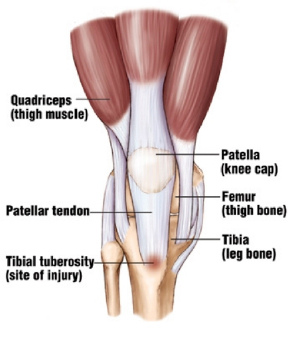What is Osgood-Schlatter syndrome?
Osgood-Schlatter syndrome is a knee condition that affects adolescents, especially those who are physically active and going through a time of growth.
What causes Osgood-Schlatter syndrome?
 The group of muscles on the front of the thigh are known as the quadriceps. The quadriceps form into tendon which then travels across the front of the knee before attaching to the shin bone (tibia) below. When contracted the quadriceps pull on the tibia via the tendon and straighten the knee. The point at which the tendon attaches onto the shin is a bony bump, this is known as the tibial tuberosity.
The group of muscles on the front of the thigh are known as the quadriceps. The quadriceps form into tendon which then travels across the front of the knee before attaching to the shin bone (tibia) below. When contracted the quadriceps pull on the tibia via the tendon and straighten the knee. The point at which the tendon attaches onto the shin is a bony bump, this is known as the tibial tuberosity.
During adolescent growth the tibial tuberosity does not completely become solid bone until growth has finished. Unfortunately although the muscles and tendons are becoming stronger during the growth phase, the tibial tuberosity lags behind. This results in a stronger pulling force from the muscles onto a weaker attachment point. If the quadriceps and tendons become too tight and therefore greater tension is placed on the shin, the shin can then fail to cope with such demand and inflammation and micro fracturing of the tibial tuberosity can occur. This causes pain and swelling of this bony bump especially during activities that require large contractions of the quadriceps such as running and jumping. In some cases when the pulling force from the muscles and tendons is too great, a part of the tibial tuberosity bone may become partially dislodged.
Symptoms
Symptoms of Osgood-Schlatter syndrome can include:
- Pain over the tibial tuberosity when straightening the knee or squatting.
- Pain over the tibial tuberosity when running or going up and down stairs.
- A swollen tibial tuberosity or inflamed skin over the tibial tuberosity
- A loss of strength or size in the quadriceps muscles
Diagnosis
Osgood-Schlatter syndrome is diagnosed by physiotherapy assessment. Depending on the severity, further testing such as X-Ray and ultrasound scan may be required.
Treatment
- Treatment will generally begin the physiotherapist modifying the amount of physical activity, which can include partial or complete rest from activity. This will depend on the individual severity.
- Icepacks and the use of analgesics and anti-inflammatory medication to reduce pain and swelling.
- Tailor made stretching and strengthening exercises for the lower limb muscles to off load and stabilize the tibial tuberosity.
- In rare cases, surgery is required once growth has ended.
Prognosis
Prognosis is good? in Osgood-Schlatter syndrome, especially if physiotherapy is commenced early. In most cases the condition will completely resolve with no residual pain or deficit.
